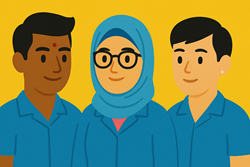Introduction

Nurses are at the forefront of emerging clinical specialisms and care for a wide range of patient populations. Providing high-quality, patient-centred care for individuals with neurodiverse conditions is an essential part of modern nursing practice.
Supporting neurodiverse patients requires effective communication, an understanding of their individual needs, and the ability to make reasonable adjustments across various clinical environments.
This resource is designed to help you reflect on and enhance your practice across different settings and specialisms, ensuring more inclusive, compassionate and tailored care for people with neurodiverse conditions.
Neurodiversity refers to natural differences in how people think, learn, process information, and interact with the world. It recognises that no one's brain functions in the same way. These variations may affect mood, behaviour, learning and cognitive functions.
Often, people who are neurodiverse have more than one of these conditions. However, for this guidance, we are including those as neurodiverse as the following (please note, this is not an exhaustive list):
- Dyslexia
- Dysgraphia
- Dyspraxia
- Dyscalculia
- Attention Deficit Hyperactivity Disorder (ADHD)
- Tourette’s syndrome
- Autistic Spectrum Condition (ASC).
The term ‘Specific Learning Difference’ (SpLD) refers to a difference/difficulty that an individual has with a particular aspect of learning. The most common SpLDs are dyslexia, dyspraxia, ADD, ADHD, dyscalculia and dysgraphia.
Nursing staff are present at many stages of patients' health care journeys. For those with a neurodiverse condition, interacting with staff who know and understand their requirements promotes a sense of trust. Nursing staff are key in supporting patients in often vulnerable or complex conditions.
At the heart of neurodiversity is the idea that individual differences are not weaknesses, but that society imposes expectations based on a majority neurotypical population. When not met, these differences can lead to challenges. By applying a social model approach, we can appreciate that individual differences are not the problem but rather external barriers. By removing these barriers, we build a more inclusive society that values individual strengths and differences.
Neurodivergence is experienced differently by different people. Experiences are influenced by other factors such as race, cultural background and gender (this interplay of factors is referred to as ‘intersectionality’).

Neurodivergence is the term for when someone's brain processes, learns, and/or behaves differently from what is considered ‘typical’. Some neurodivergent conditions include:
- Dyslexia
- Dyspraxia (also called Developmental Coordination Disorder, or DCD)
- Dyscalculia
- Attention Deficit Hyperactivity Disorder (ADHD)
- Autism Spectrum Condition (ASC).
These conditions often co-occur, and many symptoms overlap, as shown in the diagram. Neurodivergent groups may be more highly represented in health and social care professions than the general population.













